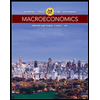
The actions of FED to move from high
Explanation of Solution
The Phillips curve is used by the economists to depict the short-run relation between the inflation rate and the unemployment rate in an economy. The inflation rate and the unemployment rate are the two evils which every economy tries to minimize in the short-run as well as in the long-run. But, the government cannot reduce them both at the same time. When they focus on reducing the unemployment rate, it will lead to an increase in the inflation rate and vice versa. This trade-off between the inflation rate and unemployment is explained with the help of the Phillips curve.
In order to eradicate unemployment, the FED would like to take the expansionary
Thus, the expansionary monetary policy by the FED increases the aggregate demand of the economy, which will cause the real GDP to increase along with the price level and lowering the rate of unemployment in the economy. So in order to move from a point on Phillips curve which represents higher unemployment rate with lower inflation rate to a point where the unemployment rate is lower and the inflation rate is higher, the FED should undertake the expansionary monetary policy.
Concept introduction:
Phillips curve: Phillips curve shows the relationship and trade-off between the inflation rate and unemployment rate in an economy during the short-run period.
Want to see more full solutions like this?
Chapter 17 Solutions
Macroeconomics (7th Edition)
- Homework (Ch 23) The following graph shows a short-run Phillips curve for a hypothetical economy. Show the short-run effect of a contractionary monetary policy by dragging the point along the short-run Phillips curve (SRPC) or shifting the curve to the appropriate position. ? 12 11 10 9 1 INFLATION RATE (Percent) 8 I SRPC H SRPC Q Clarrow_forwardSuppose that the current inflation rate is at 9% and the unemployment rate is 3%. Given this data. what monetary policy action would should the Federal Reserve take? How would this affect the economy, the inflation rate, and the unemployment rate?arrow_forwardIf firms and workers have adaptive expectations, what impact will contractionary monetary policy have on inflation, unemployment, and the Phillips curve? If expectations are adaptive, how will the economy adjust to a new, long-run equilibrium in response to contractionary monetary policy?arrow_forward
- Now go to FRED and search for PCEPI. This is the price index that receives the most attention from the Federal Reserve in terms of fulfilling the nominal part of their dual mandate. Calculate the most recent rate of inflation (12 months) using PCEPI to the nearest two decimal places and compare to the Fed's implicit target of inflation = 2%. Is inflation too high, too low, or just right (circle your answer)? TPCE Too high Too low Just rightarrow_forwardWhich of the following is NOT one of the factors in the FED "rule" used to determine if Monetary Policy action is required? other factors like world events that may impact the US economy price level and inflation the marginal propensity to consume (MPC) real GDP and its effect on unemployment ratesarrow_forwardExplain The FED's inflation Targetarrow_forward
- The Fed has an obligation of the "full employment mandate". What is that exactly? How is it connected to the setting of interest rates?arrow_forwardExplain the FED role to cope with rising inflation.arrow_forwardThe following graph plots a short-run Phillips curve for a hypothetical economy. Show the short-run effect of a contractionary monetary policy by dragging the point along the short-run Phillips curve (SRPC) or shifting the curve to the appropriate position. Now, show the long-run effect of a contractionary monetary policy by dragging either the short-run Phillips curve (SRPC), the long-run Phillips curve (LRPC), or both. As anticipated, inflation (rises/falls) and the short-run Phillips curve shifts (downward/upward) , highlighting the cost of fighting inflation, which is (higher unemployment in the long run/temporary unemployment/lower unemployment) . Which of the following examples represents a cost of inflation? Check all that apply. -An unintended redistribution of wealth from borrowers to lenders -A general decrease in purchasing power -Increased variability of relative prices -A coffee shop’s costs to reprint its menu to reflect fluctuating pricesarrow_forward
- The "rational expectations" school of economists, including Robert Lucas and Thomas Sargent, argue that changes in monetary policy cannot affect unemployment rates in the short run or long run. True Falsearrow_forwardWhat is the appropriate monetary policy to be implemented by the Federal Reserve System during periods of high inflation? Explain the steps the Fed will take.arrow_forwardIf wages and prices adjust slowly, we would expect expansionary monetary policy to be less likely to reduce the natural unemployment rate. more likely to reduce inflation. more likely to affect the unemployment rate. more likely to result in a vertical short-run Phillips curve.arrow_forward
 Economics: Private and Public Choice (MindTap Cou...EconomicsISBN:9781305506725Author:James D. Gwartney, Richard L. Stroup, Russell S. Sobel, David A. MacphersonPublisher:Cengage Learning
Economics: Private and Public Choice (MindTap Cou...EconomicsISBN:9781305506725Author:James D. Gwartney, Richard L. Stroup, Russell S. Sobel, David A. MacphersonPublisher:Cengage Learning Macroeconomics: Private and Public Choice (MindTa...EconomicsISBN:9781305506756Author:James D. Gwartney, Richard L. Stroup, Russell S. Sobel, David A. MacphersonPublisher:Cengage Learning
Macroeconomics: Private and Public Choice (MindTa...EconomicsISBN:9781305506756Author:James D. Gwartney, Richard L. Stroup, Russell S. Sobel, David A. MacphersonPublisher:Cengage Learning
 Economics (MindTap Course List)EconomicsISBN:9781337617383Author:Roger A. ArnoldPublisher:Cengage Learning
Economics (MindTap Course List)EconomicsISBN:9781337617383Author:Roger A. ArnoldPublisher:Cengage Learning






